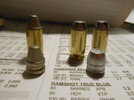So when talking about cast bullet design being a SWC, RNFP, or WFP, there are some distinct differences in shape and performance.
So as mentioned the semi wad cutter (SWC) is a time honored design being it has a small meplat tapering into a sharp wider shoulder which usually results in a nice clean cut hole, whether it be in flesh or on paper. They have a tendency for being very accurate out of most calibers used and account for a good bit of game. They usually penetrate straight though leaving an almost caliber sized hole in their wake. Unless they encounter something substantial like solid bone they usually do not expand much. They are usually really accurate to longer ranges than most.
The round nose flat point (RNFP) is another throw back to the black powder days when most things were of a maxi ball type design, and a lot of them resulted from the as mentioned lever action tubular magazines. They have a tendency of punching a deep nearly caliber hole and are generally used when deep penetration and broken bones is wanted. Depending upon the alloy and impact velocity they may or may not expand much, but can be cast of an alloy which is on the softer side to allow some.
The newer designs (relatively speaking) like Veral Smith and other's Wide Flat Nose (WFN) were brought about to try and deliver the best of tissue disruption and penetration, usually giving a wider wound channel than would normally be expected from a solid bullet and closer to what might be seen using an expanding bullet. These are usually cast from harder alloy such as one of the type alloys. (Lino, Mono, ect) or they can be hardened by quenching to bring up the BHN. Either, or, the tendency is for a harder bullet to reduce any expansion to a minimum for increased penetration. They have an almost bore diameter nose width, and very minimal taper going towards the bearing surface. They hit really hard but they aren't very good for long range.
The cast hollow point (CHP) is a great bullet but it is dependent upon the alloy being malleable and the impact velocity not exceeding the ability of the alloy to hold together. I use these with all of my hunting handguns, but I also spent the better part of two years working the alloy up to hold together over the ranges of impact velocity I might encounter with the calibers I shoot them in. Some molds allow them to be cast with a variety of pins which can also effectively help control the expansion. A cup point, or small diameter shallow point will not expand as efficiently as a wide deep point will. Therefore this can be used when pouring the same bullet style and alloy to get different results upon impact, or within a higher impact velocity. (38/44spl vs 357/44mag)
Since I hunt with a variety of revolvers, I have become very attached to the newer HP mold offerings. Most come with a solid pin as well and are usually of the round flat nose design of sorts. However I also have several of these type molds for SWC's which also have pin assortments to allow them to be cast as HP as well. I normally use these in my larger calibers. Even so with these I can also simply adjust the alloy and use them with no HP and still get expansion if I want it.
Most of the alloy I shoot regardless of caliber runs below a 13 BHN. I just find that it works well and if I slam a hog up close with my 45 Colt using the 280gr RFN I might or might not get expansion , but with that bullet it still usually goes right on through. Either way it is going to leave at least close to a half inch hole going in and wreck everything in it's path going through.







